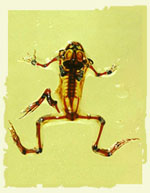Malformed Frogs
Deformities in populations of Minnesota frogs
In recent years, there has been an increase in the incidence of frog deformities throughout many of the northern states of North America, followed by rapid declines in the abundances of species of frogs that are affected (mostly species that spend long time periods as tadpoles). The most readily noticed malformations involve the hindlimbs of peri-metamorphic animals. During my undergraduate I worked with Dr. David Hoppe and analyzed skeletal preparations of metamorphosing mink frogs (Rana septentrionalis) collected from a site in Minnesota, in order to develop a better understanding of the possible causes. Potential explanations for limb malformities are mechanical disruption of limb formation by parasitic trematode infestations, exposure to chemical contamination, specifically retinoic acid, and ultraviolet radiation. Specifically I was looking at frogs collected in Minnesota to determine if they had trematode cysts associated with areas that displayed developmental deformities. The spectrum of deformities includes missing limbs, truncated limbs, extra limbs (including extra pelvic girdles), bony triangles (proximal and distal ends of the bone are adjacent to one another forming the base of a triangle, the shaft of the bone is bent double and protrudes laterally, the midpoint of the bone forming the apex of the triangle), and skin webbings.

